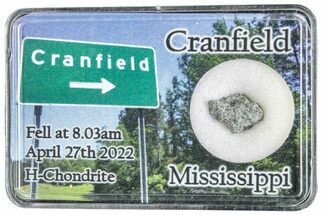1.22" Aba Panu Chondrite Meteorite (6.67 g) Slice - Witnessed Fall!
This is a 1.22" wide (6.67 gram) slice of the L3 chondrite Aba Panu. This is quite a recent witnessed fall: it exploded over the state of Oyo in Nigeria on April 19, 2018. It is a beautiful slice of the solar system's history, polished on one side to reveal its intricate interior details.
About The Aba Panu Meteorite
Aba Panu is the name given to a chondrite that fell over the Nigerian state of Oyo on April 19, 2018. The bolide was picked up by NASA's Center for Near Earth Object Studies at about 2:00 PM that day, clocked in at over 45,000 miles per hour when it entered the atmosphere! Moments later, the bolide exploded at about 30 kilometers over the Earth's surface, showering stones over the village of Aba Panu, and the towns of Ipapo and Tede to the north. To date, about 160 kilograms have been recovered, though much more could still be recovered given its large strewn field.
This is one of just seven L3 chondrite witnessed falls, and a beauty to boot! The meteorite itself has been found in sizes ranging from 30 grams to nearly 40 kilograms, occasionally featuring poorly developed regmaglypts but only rarely fusion crust. It is an L3 chondrite, densely packed with large and sometimes armored chondrules in a gray matrix, and flashing nickel-iron grains throughout. It is a truly stunning window into the beginning of the solar system.
Aba Panu is the name given to a chondrite that fell over the Nigerian state of Oyo on April 19, 2018. The bolide was picked up by NASA's Center for Near Earth Object Studies at about 2:00 PM that day, clocked in at over 45,000 miles per hour when it entered the atmosphere! Moments later, the bolide exploded at about 30 kilometers over the Earth's surface, showering stones over the village of Aba Panu, and the towns of Ipapo and Tede to the north. To date, about 160 kilograms have been recovered, though much more could still be recovered given its large strewn field.
This is one of just seven L3 chondrite witnessed falls, and a beauty to boot! The meteorite itself has been found in sizes ranging from 30 grams to nearly 40 kilograms, occasionally featuring poorly developed regmaglypts but only rarely fusion crust. It is an L3 chondrite, densely packed with large and sometimes armored chondrules in a gray matrix, and flashing nickel-iron grains throughout. It is a truly stunning window into the beginning of the solar system.
About Chondrites
Chondrites are stony (non-metallic) meteorites that have not been modified by either melting or differentiation of the parent body. They are formed when various types of dust and small grains in the early Solar System accreted to form primitive asteroids. Some such bodies are captured in the planet’s gravity well and pulled to the surface. They are by far the most common type of meteorite, representing about 86 percent of all meteorites that have fallen to Earth.
Prominent among the components present in chondrites are the enigmatic chondrules, millimeter-sized spherical objects that originated as freely floating, molten or partially molten droplets in space; most chondrules are rich in the silicate minerals olivine and pyroxene. Chondrites also contain particles of various metals such as nickel, iron, and aluminum. These formed at the very beginning of the solar system and aggregated over time: they are the oldest rocks known on Earth!
Chondrites are divided into about fifteen distinct groups on the basis of their mineralogy, bulk chemical composition, and oxygen isotope compositions. The various chondrite groups likely originated on separate asteroids or groups of related asteroids. Each chondrite group has a distinctive mixture of chondrules, refractory inclusions, matrix (dust), characteristic chondrule sizes, and other components. Other ways of classifying chondrites include weathering and shock. The L chondrite group is the most common of these.
Chondrites are stony (non-metallic) meteorites that have not been modified by either melting or differentiation of the parent body. They are formed when various types of dust and small grains in the early Solar System accreted to form primitive asteroids. Some such bodies are captured in the planet’s gravity well and pulled to the surface. They are by far the most common type of meteorite, representing about 86 percent of all meteorites that have fallen to Earth.
Prominent among the components present in chondrites are the enigmatic chondrules, millimeter-sized spherical objects that originated as freely floating, molten or partially molten droplets in space; most chondrules are rich in the silicate minerals olivine and pyroxene. Chondrites also contain particles of various metals such as nickel, iron, and aluminum. These formed at the very beginning of the solar system and aggregated over time: they are the oldest rocks known on Earth!
Chondrites are divided into about fifteen distinct groups on the basis of their mineralogy, bulk chemical composition, and oxygen isotope compositions. The various chondrite groups likely originated on separate asteroids or groups of related asteroids. Each chondrite group has a distinctive mixture of chondrules, refractory inclusions, matrix (dust), characteristic chondrule sizes, and other components. Other ways of classifying chondrites include weathering and shock. The L chondrite group is the most common of these.
$95
TYPE
L3 Chondrite
LOCATION
Aba Panu, Oyo, Nigeria
SIZE
1.22 x 1.22", .10" thick, 6.67 grams
CATEGORY
SUB CATEGORY
ITEM
#307258
 Reviews
Reviews









